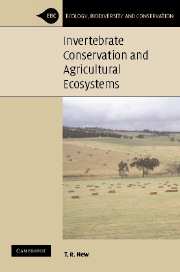Book contents
- Frontmatter
- Contents
- Preface
- Acknowledgements
- 1 Introduction: agricultural ecosystems and conservation
- 2 Agriculture and biodiversity: the place of invertebrates
- 3 Agriculture: effects on invertebrate diversity and conservation
- 4 Agricultural disturbance: diversity and effects on invertebrates
- 5 Biological control and invertebrate conservation
- 6 Cultural aspects of pest management
- 7 Extending beyond cropping areas
- 8 Field margins and landscape ecology
- 9 Pasture management and conservation
- 10 Towards more holistic management for invertebrates
- References
- Index
6 - Cultural aspects of pest management
Published online by Cambridge University Press: 29 July 2009
- Frontmatter
- Contents
- Preface
- Acknowledgements
- 1 Introduction: agricultural ecosystems and conservation
- 2 Agriculture and biodiversity: the place of invertebrates
- 3 Agriculture: effects on invertebrate diversity and conservation
- 4 Agricultural disturbance: diversity and effects on invertebrates
- 5 Biological control and invertebrate conservation
- 6 Cultural aspects of pest management
- 7 Extending beyond cropping areas
- 8 Field margins and landscape ecology
- 9 Pasture management and conservation
- 10 Towards more holistic management for invertebrates
- References
- Index
Summary
Cultural control emphasises making environmental manipulations within and near agroecosystems to hinder the pest or to promote local wellbeing of native natural enemies. This practice is motivated largely by needs to promote conservation biological control as a means of overcoming some of the fears and practical problems that arise over use of exotic control agents. Habitat modifications include a wide variety of changes in agricultural practices in space and time, many involving lessening the intensity of human interventions. The wider benefits of such changes can be considerable and represent an active current endeavour to enhance invertebrate conservation in agroecosystems.
Introduction
This third chapter on the implications of the major components of modern crop protection for conservation introduces the various aspects of ‘cultural controls’, in which the crop environment and its surroundings are manipulated to help in pest management. Such methods constitute a third major strand to IPM, together with pesticides and biological control. The major principle is that availability of resources needed for the wellbeing of pests or of their natural enemies can be influenced in space and time by agricultural practices, so that manipulations to the crop environment may decrease the incidence anad impacts of pests and increase that of natural enemies. Such modifications may therefore be important in pest management but may also harm or benefit natural biota, including the numerous invertebrates associated with agroecosystems and nearby areas.
- Type
- Chapter
- Information
- Invertebrate Conservation and Agricultural Ecosystems , pp. 189 - 212Publisher: Cambridge University PressPrint publication year: 2005

